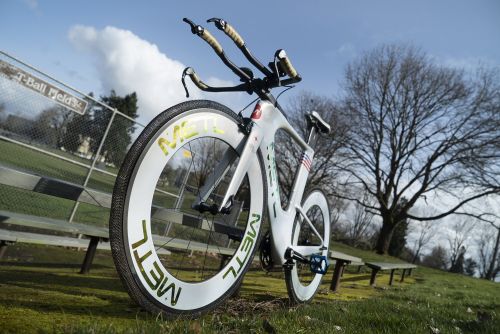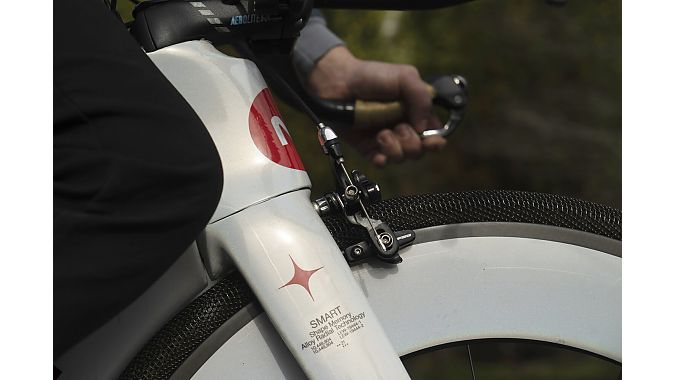A version of this article ran in the May issue of BRAIN.
CLEVELAND (BRAIN) — The Smart Tire Company announced in March plans to manufacture an airless bike tire in partnership with NASA. While the space-age tie-in grabbed the headlines initially, it’s Smart Tire’s partnership with micromobility company Spin and Felt Bicycles that might have a more lasting impact.
Owned by the Ford Motor Company, Spin operates dockless e-scooter mobility fleets in U.S. cities and university campuses. It also has fleets in Canada, Germany, United Kingdom, and Spain.
That’s a lot of rubber in need of inflating, maintenance, and eventually replacing. And Smart Tire thinks it has the answer with the METL tire while at the same time manufacturing a recyclable product and reducing rubber waste.
“If you work with a company like that, they understand total cost, and they’re looking at it from a different view than a consumer,” said Smart Tire co-founder Brian Yennie about the Spin partnership.
A Spin spokesperson said the METL is an ideal fit for its fleets, combining the durability of solid tires with the supple ride of pneumatic. “The implications of this new technology are potentially transformative, with flat and worn-out tires becoming a thing of the past,” the spokesperson told BRAIN.
It’s all about Shape Memory Alloy
The METL, expected on the consumer market in the spring of summer of 2022 with the MSRP to be determined, came to be from the collaboration with NASA, which needed an airless tire for its Lunar and Mars Rover missions. Shape Memory Alloy — think inner tube — makes up the tire skeleton with rubber encasing it. It has the added benefit of allowing retreading.
The METL is manufactured in Cleveland, which is also home to the NASA Glenn Research Center, Goodyear and Cooper Tires.
“The other advantage we have there is because it’s not pneumatic and the rubber is not structural, we can just focus on the tread element,” Yennie said. “We can potentially make that thicker. We can potentially get into chemical engineering a little differently there.”
That would appeal to bike-share fleets and e-bike commuters who don’t want to worry about flats and inflation, Yennie added.
“Because the structural element is meant to last the lifetime of your bike, we’re trying to pair that with the longest lasting tread we possibly can,” Yennie said. “One of our NASA team members is out of Goodyear, so we have that automotive experience.”
That wire structural element is good at resisting deformations, Yennie said, but if it is damaged beyond repair, it can be melted and recycled.
Yennie said Smart Tire’s goal is for the consumer to buy one set of tires for the life of the bike.
“The pessimist will say there’s always ways to damage it,” he said. “We didn’t re-invent rubber; however, given all of our advantages, the goal here is to have the closest thing to a no-maintenance tire as we possibly can.”
While micromobility applications seem limitless, Smart Tire isn’t ignoring retail applications in the road, gravel, and mountain bike markets, and that’s where Felt Bicycles enters the picture. Felt is providing research and development (weight and rolling resistance) for the METL and providing bikes to test prototypes.
Felt Bicycles’ involvement
Yennie added there’s potential to form an OEM partnership with Felt down the line, “but the actual relationship there now is on the R&D side.”
Eric Sakalowsky of Felt said the benefit of the METL technology for bike-share companies and the e-bike industry on the whole is immense. “We suspect that weight will come down as the development progresses,” Sakalowsky said. “And, there could be other advantages that outweigh — pun — the negatives. It’ll be exciting to see this proceed.”
Sakalowsky said the METL’s potential benefit to the industry piqued Felt’s interest in the project, despite naysayers who might argue an airless tire will have trouble gaining market traction.
“There's always push back with disruption, as people get set in their ways,” Sakalowsky said. “But we should never stop innovating to find new ways in making cycling better and safer. This is an exciting application of an innovative technology used in space and that alone inspires us.”
Competitive road cyclists will no doubt look warily at the METL, but Yennie said he expects the gravel and mountain bike tires to be comparable in weight to traditional rubber. “Over time, I see us continuing to optimize and dropping that weight depending on how much demand there is.”
To achieve different ride characteristics with a regular tire, air pressure is manipulated. With the METL, different tire compounds will be available. “We’re actively researching mechanisms to be able to adjust that on the fly,” Yennie said. “I can’t speak to the specifics on that right now. If you look at the structure of the tires, if you look at that skeleton, you can imagine ways to tighten and loosen what you’re running on there.”
The METL initially will be available direct-to-consumer, but Yennie wants to eventually reach retailers.
“I think there’s a challenge there in terms of customer education and things like the retread program,” he said. “Rolling that out to say 4,000 specialty retailers, operationally, that would be pretty complex for us. We obviously want to be everywhere, but B2C allows us to control the narrative and talk to the customer. We’ll definitely be exploring the retail aspect.”




